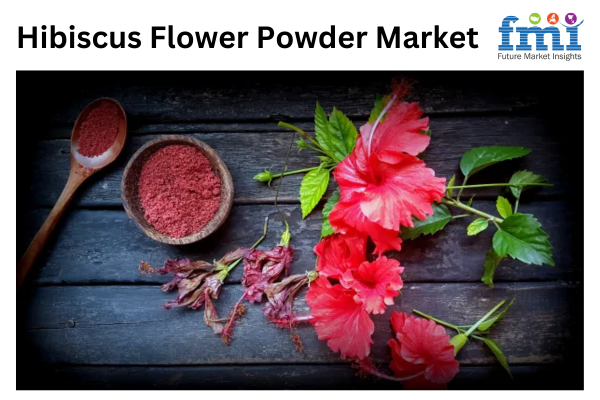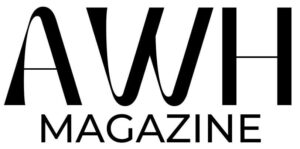U.S. Hibiscus Flower Powder Market to Grow at a 4.5% CAGR Through 2034, Driven by Rising Demand for Natural and Functional Ingredients Across Food, Beverage, Cosmetics, and Dietary Supplements Sectors.
NEWARK, Del, Sept. 10, 2024 (GLOBE NEWSWIRE) — The global hibiscus flower powder market is projected to hit a value of USD 127.8 million by 2024, fueled by its growing use in non-food applications. This trend is set to open new market opportunities, with an anticipated compound annual growth rate (CAGR) of 5.4% from 2024 to 2034. By 2034, the market is expected to reach around USD 215.4 million.
Understanding the Hibiscus Flower Powder Market
The Hibiscus Flower Powder market has been gaining traction due to the rising popularity of natural and organic health products. Hibiscus, known for its vibrant red color and tart flavor, is celebrated for its rich content of antioxidants, vitamins, and minerals. These properties make it a sought-after ingredient in various health and wellness products, including teas, supplements, and beauty products. The market is driven by increasing consumer awareness of the benefits of hibiscus, such as its potential to support cardiovascular health, improve digestion, and provide anti-inflammatory effects.
In addition to health benefits, the hibiscus flower powder market is also influenced by growing trends in plant-based and functional foods. As consumers become more conscientious about their dietary choices and seek alternatives to synthetic ingredients, hibiscus flower powder offers a natural option with a wide range of applications.
Key Takeaways from the Market Study
- Global hibiscus flower powder market was valued at US$ 93.2 million in 2019.
- From 2019 to 2023, the market demand expanded at a CAGR of 5.0%.
- The market in Japan is expected to expand at a CAGR of 4.9% through 2034.
- By packaging type, the packets segment to account for a share of 45.2% in 2024.
- The market in India is expected to expand at a CAGR of 10.7% through 2034.
- In terms of nature, the conventional segment to account for a share of 79.3% in 2024.
“Rising globalization and trade liberalization initiatives facilitate the cross border movement of hibiscus flower powder, opening up new markets and opportunities for producers and exporters,” says Nandini Roy Choudhury, Client Partner at Future Market Insights.
Country-wise Insights
| Countries | Forecast CAGRs from 2024 to 2034 | |
| The United States | 4.5% | |
| Germany | 3.5% | |
| China | 4.5% | |
| Japan | 4.9% | |
| India | 10.7% | |
Competitive Landscape
Prominent players in the hibiscus flower powder market are Bio Organic, Herbeno Herbals, The Republic of Tea, Traditional Medicinals, Bio Actives, Wild Hibiscus Flower Co., Rena Beverage Solutions, and Fortune Health Care, among others.
Company Portfolio
- The Republic of Tea provides premium quality hibiscus flower powder as part of its extensive tea offerings. Their hibiscus flower powder adds a tart and floral note to teas, contributing to unique and refreshing flavors enjoyed by tea enthusiasts.
- Traditional Medicinals offers organic hibiscus flower powder known for its health promoting properties. Their hibiscus flower powder is used in herbal blends and wellness teas, valued for its antioxidant rich and soothing qualities.
Prominent Drivers of the Hibiscus Flower Powder Market
- Rising Health Consciousness: There is an increasing awareness among consumers about the health benefits of natural and organic products. Hibiscus flower powder, known for its rich content of antioxidants, vitamins, and minerals, appeals to health-conscious individuals looking for natural ways to enhance their well-being.
- Growing Demand for Natural Ingredients: The trend towards natural and organic ingredients in food and beverages is driving the hibiscus flower powder market.
- Expansion of Functional Foods and Beverages: The functional foods and beverages sector is booming, with consumers seeking products that offer added health benefits. Hibiscus flower powder is popular in functional beverages due to its potential benefits such as improving blood pressure and supporting cardiovascular health.
- Increased Use in Cosmetics and Personal Care: The hibiscus flower powder is increasingly used in cosmetics and personal care products for its anti-aging properties and skin benefits.
- Cultural and Traditional Practices: Hibiscus has been used in various traditional medicine practices around the world. This cultural significance continues to drive interest and demand, particularly in regions where traditional practices are prevalent.
- Rising Demand in Emerging Markets: Emerging markets, particularly in Asia and Africa, are experiencing a surge in demand for hibiscus flower powder. This growth is driven by increasing consumer awareness, rising disposable incomes, and a shift towards healthier lifestyles.

More Valuable Insights Available
Future Market Insights offers an unbiased analysis of the global hibiscus flower powder market, providing historical data for 2019 to 2023 and forecast statistics from 2024 to 2034.
To understand opportunities in the hibiscus flower powder market, the market is segmented on the basis of packaging type (packets, bags, cardboard boxes), nature (organic, conventional), application (pharmaceutical, food and beverages, cosmetics, skin care, others), and sales channel (B2B, B2C, hypermarket/supermarket, specialty stores, discount stores, online retailing), across seven major regions (North America, Latin America, Western Europe, Eastern Europe, South Asia & Pacific, East Asia, and the Middle East & Africa).
Browse full Report: https://www.futuremarketinsights.com/reports/hibiscus-flower-powder-market
Segmentation Analysis of the Hibiscus Flower Powder Market
By Packaging Type:
- Packets
- Bags
- Cardboard Boxes
By Nature:
By Application:
- Pharmaceutical
- Food and Beverages
- Cosmetics
- Skin Care
- Others
By Sales Channel:
- B2B
- B2C
- Hypermarket/Supermarket
- Specialty Stores
- Discount Stores
- Online Retailing
By Region:
- North America
- Latin America
- Western Europe
- Eastern Europe
- South Asia and Pacific
- East Asia
- The Middle East and Africa
Spanish Translation:
Se prevé que el mercado mundial de polvo de flor de hibisco alcance un valor de 127,8 millones de dólares en 2024, impulsado por su creciente uso en aplicaciones no alimentarias. Se prevé que esta tendencia abra nuevas oportunidades de mercado, con una tasa de crecimiento anual compuesta (CAGR) prevista del 5,4 % entre 2024 y 2034. Para 2034, se espera que el mercado alcance unos 215,4 millones de dólares.
Comprender el mercado del polvo de flor de hibisco
El mercado del polvo de flor de hibisco ha ido ganando terreno debido a la creciente popularidad de los productos de salud naturales y orgánicos. El hibisco, conocido por su color rojo vibrante y su sabor ácido, es famoso por su rico contenido de antioxidantes, vitaminas y minerales. Estas propiedades lo convierten en un ingrediente muy buscado en diversos productos de salud y bienestar, incluidos tés, suplementos y productos de belleza. El mercado está impulsado por la creciente conciencia de los consumidores sobre los beneficios del hibisco, como su potencial para favorecer la salud cardiovascular, mejorar la digestión y proporcionar efectos antiinflamatorios.
Además de los beneficios para la salud, el mercado del polvo de flor de hibisco también está influenciado por las tendencias crecientes en alimentos funcionales y de origen vegetal. A medida que los consumidores se vuelven más conscientes de sus elecciones dietéticas y buscan alternativas a los ingredientes sintéticos, el polvo de flor de hibisco ofrece una opción natural con una amplia gama de aplicaciones.
Conclusiones clave del estudio de mercado
El mercado mundial del polvo de flor de hibisco se valoró en 93,2 millones de dólares estadounidenses en 2019.
De 2019 a 2023, la demanda del mercado se expandió a una CAGR del 5,0 %.
Se espera que el mercado en Japón se expanda a una CAGR del 4,9 % hasta 2034.
Por tipo de envase, el segmento de paquetes representará una participación del 45,2 % en 2024.
Se espera que el mercado en la India se expanda a una CAGR del 10,7 % hasta 2034.
En términos de naturaleza, el segmento convencional representará una participación del 79,3 % en 2024.
“La creciente globalización y las iniciativas de liberalización del comercio facilitan el movimiento transfronterizo del polvo de flor de hibisco, abriendo nuevos mercados y oportunidades para productores y exportadores”, dice Nandini Roy Choudhury, socio de clientes de Future Market Insights.
Panorama competitivo
Los actores destacados en el mercado del polvo de flor de hibisco son Bio Organic, Herbeno Herbals, The Republic of Tea, Traditional Medicinals, Bio Actives, Wild Hibiscus Flower Co., Rena Beverage Solutions y Fortune Health Care, entre otros.
Cartera de la empresa
· The Republic of Tea ofrece polvo de flor de hibisco de primera calidad como parte de su amplia oferta de tés. Su polvo de flor de hibisco agrega una nota ácida y floral a los tés, lo que contribuye a sabores únicos y refrescantes que disfrutan los entusiastas del té.
· Traditional Medicinals ofrece polvo de flor de hibisco orgánico conocido por sus propiedades que promueven la salud. Su polvo de flor de hibisco se utiliza en mezclas de hierbas y tés de bienestar, valorados por sus cualidades ricas en antioxidantes y calmantes.
Impulsores destacados del mercado del polvo de flor de hibisco
1. Creciente conciencia de la salud: existe una creciente conciencia entre los consumidores sobre los beneficios para la salud de los productos naturales y orgánicos. El polvo de flor de hibisco, conocido por su rico contenido de antioxidantes, vitaminas y minerales, atrae a las personas preocupadas por la salud que buscan formas naturales de mejorar su bienestar.
2. Creciente demanda de ingredientes naturales: la tendencia hacia los ingredientes naturales y orgánicos en alimentos y bebidas está impulsando el mercado del polvo de flor de hibisco.
3. Expansión de los alimentos y bebidas funcionales: El sector de los alimentos y bebidas funcionales está en auge, y los consumidores buscan productos que ofrezcan beneficios adicionales para la salud. El polvo de flor de hibisco es popular en las bebidas funcionales debido a sus posibles beneficios, como mejorar la presión arterial y favorecer la salud cardiovascular.
4. Mayor uso en cosméticos y cuidado personal: El polvo de flor de hibisco se utiliza cada vez más en cosméticos y productos de cuidado personal por sus propiedades antienvejecimiento y sus beneficios para la piel.
5. Prácticas culturales y tradicionales: El hibisco se ha utilizado en diversas prácticas de medicina tradicional en todo el mundo. Esta importancia cultural sigue impulsando el interés y la demanda, en particular en las regiones donde prevalecen las prácticas tradicionales.
6. Aumento de la demanda en los mercados emergentes: Los mercados emergentes, en particular en Asia y África, están experimentando un aumento de la demanda de polvo de flor de hibisco. Este crecimiento está impulsado por una mayor conciencia de los consumidores, el aumento de los ingresos disponibles y un cambio hacia estilos de vida más saludables.
Más información valiosa disponible
Future Market Insights ofrece un análisis imparcial del mercado global de polvo de flor de hibisco, que proporciona datos históricos de 2019 a 2023 y estadísticas de pronóstico de 2024 a 2034.
Para comprender las oportunidades en el mercado de polvo de flor de hibisco, el mercado se segmenta en función del tipo de empaque (paquetes, bolsas, cajas de cartón), naturaleza (orgánico, convencional), aplicación (farmacéutica, alimentos y bebidas, cosméticos, cuidado de la piel, otros) y canal de ventas (B2B, B2C, hipermercado/supermercado, tiendas especializadas, tiendas de descuento, venta minorista en línea), en siete regiones principales (América del Norte, América Latina, Europa Occidental, Europa del Este, Asia del Sur y el Pacífico, Asia del Este y Oriente Medio y África).
Análisis de segmentación del mercado de polvo de flor de hibisco
Por tipo de embalaje:
• Paquetes
• Bolsas
• Cajas de cartón
Por naturaleza:
• Orgánico
• Convencional
Por aplicación:
• Farmacéutica
• Alimentos y bebidas
• Cosméticos
• Cuidado de la piel
• Otros
Por canal de venta:
• B2B
• B2C
o Hipermercado/Supermercado
o Tiendas especializadas
o Tiendas de descuento
o Venta minorista en línea
Por región:
• América del Norte
• América Latina
• Europa occidental
• Europa del Este
• Asia meridional y el Pacífico
• Asia oriental
• Oriente Medio y África
Authored by:
Nandini Roy Choudhury (Client Partner for Food & Beverages at Future Market Insights, Inc.) has 7+ years of management consulting experience. She advises industry leaders and explores off-the-eye opportunities and challenges. She puts processes and operating models in place to support their business objectives.
She has exceptional analytical skills and often brings thought leadership to the table.
Nandini has vast functional expertise in key niches, including but not limited to food ingredients, nutrition & health solutions, animal nutrition, and marine nutrients. She is also well-versed in the pharmaceuticals, biotechnology, retail, and chemical sectors, where she advises market participants to develop methodologies and strategies that deliver results.
Her core expertise lies in corporate growth strategy, sales and marketing effectiveness, acquisitions and post-merger integration and cost reduction. Nandini has an MBA in Finance from MIT School of Business. She also holds a Bachelor’s Degree in Electrical Engineering from Nagpur University, India.
Nandini has authored several publications, and quoted in journals including Beverage Industry, Bloomberg, and Wine Industry Advisor.
Explore FMI’s related ongoing Coverage in Food and Beverage Domain:
According to the research of Future Market Insights, the market for Ahiflower Oil is anticipated to expand at a CAGR of 4.4% over the forecasted time period.
According to the research of Future Market Insights, over the projected period, the market for flower extract is expected to expand at a CAGR of 5.2%.
The safflower oil market Size is likely to be worth US$ 232.1 million by 2023, recording a 4.5% CAGR from 2023 to 2033. The safflower seed oil market is expected to hit US$ 359 million by 2033.
Global passion flower extract demand is anticipated to be valued at US$ 3.5 Billion in 2022, forecast to grow at a CAGR of 3.6% to be valued at US$ 5.0 Billion from 2022 to 2032.
The global pectin powder market is set to relish a market valuation of US$ 1,011.0 million in 2023, Demand for pectin powder is likely to develop at a CAGR of 5.6% between 2023 and 2033, reaching around US$ 1,745.8 million by 2033.
The global superfood powders market is poised to surpass US$ 6.84 billion by 2023, surging at a remarkable CAGR of 7% through 2033 to reach US$ 13.66 billion.
According to Future Market Insights research, during the projected period, the Global Achiote Powder is expected to grow at an of CAGR 4.2%.
The global spirulina powder market size is projected to rise from US$ 461 million in 2024 to US$ 702 million by 2034. By 2034, spirulina powder sales are projected to soar at 5.9% CAGR.
The fruit powder market is anticipated to grow at a 7.4% CAGR between 2023 and 2033, according to the Future Market Insights (FMI) estimation. By 2033, the fruit powder market is poised to be valued from US$ 17.5 billion in 2033 to US$ 36.4 billion.
The overall sales of beetroot powder products are projected to grow at a robust CAGR of 4.6% between 2023 and 2033, totaling around US$ 741.7 million by the end of 2033.
About Future Market Insights (FMI)
Future Market Insights, Inc. (ESOMAR certified, recipient of the Stevie Award, and a member of the Greater New York Chamber of Commerce) offers profound insights into the driving factors that are boosting demand in the market. FMI stands as the leading global provider of market intelligence, advisory services, consulting, and events for the Packaging, Food and Beverage, Consumer Technology, Healthcare, Industrial, and Chemicals markets. With a vast team of over 400 analysts worldwide, FMI provides global, regional, and local expertise on diverse domains and industry trends across more than 110 countries.
Contact FMI:
Future Market Insights Inc.
Christiana Corporate, 200 Continental Drive,
Suite 401, Newark, Delaware – 19713, USA
T: +1-845-579-5705
For Sales Enquiries: [email protected]
Website: https://www.futuremarketinsights.com
LinkedIn| Twitter| Blogs | YouTube

Legal Disclaimer:
EIN Presswire provides this news content “as is” without warranty of any kind. We do not accept any responsibility or liability
for the accuracy, content, images, videos, licenses, completeness, legality, or reliability of the information contained in this
article. If you have any complaints or copyright issues related to this article, kindly contact the author above.
![]()
Originally published at https://www.einpresswire.com/article/742242916/global-hibiscus-flower-powder-market-to-reach-a-valuation-of-usd-215-4-million-by-2034-future-market-insights-inc





